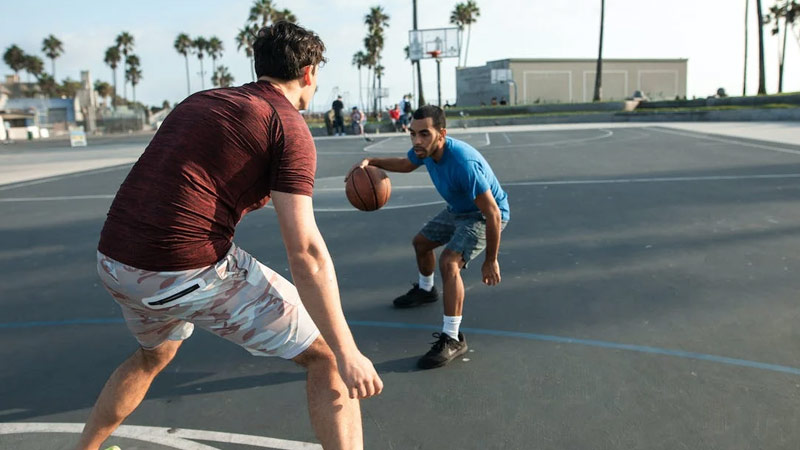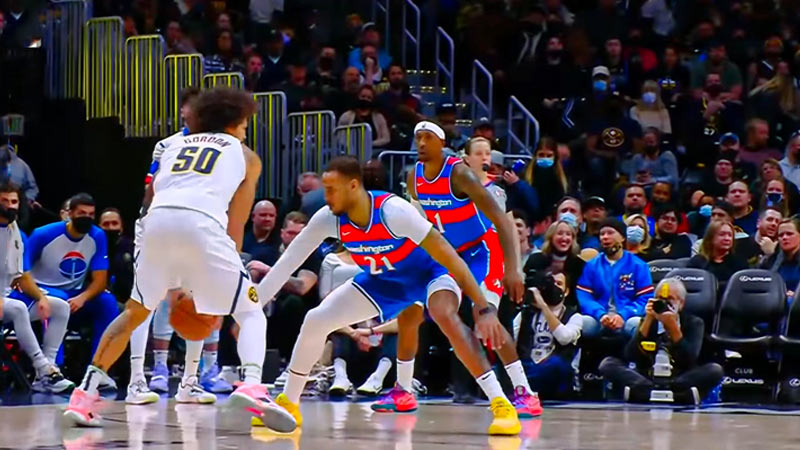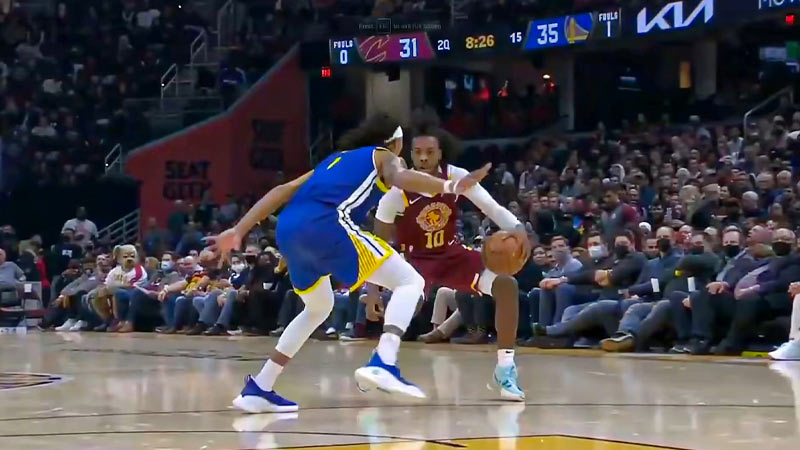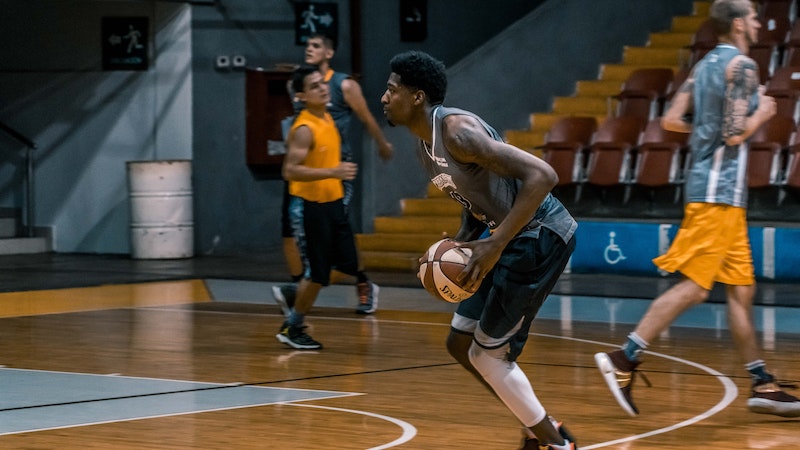Basketball is a fast-paced and exciting sport that has captivated fans around the world for decades. With its unique rules and regulations, it can sometimes be challenging to keep up with all the terminology and infractions.
One such violation that often confuses newcomers to the game is the double dribble. So, what does double dribble mean in basketball? Let’s find out.
What Does Double Dribble Mean in Basketball?
In basketball, dribbling is the act of bouncing the ball with one hand while moving or stationary. It allows players to maintain control of the ball while maneuvering around the court.
However, there are specific rules that govern dribbling, and one of them is the prohibition of double dribble.
Double dribble occurs when a player dribbles the ball with both hands simultaneously or picks up the dribble and then dribbles again before either shooting, passing, or coming to a complete stop.
It is essentially an illegal dribbling violation, resulting in the opposing team being awarded possession of the ball.
To better understand this rule, let’s break it down into two scenarios:
Simultaneous Dribbling with Both Hands
According to the rules of basketball, a player can only dribble the ball using one hand at a time. If a player attempts to dribble the ball by bouncing it simultaneously with both hands or by briefly placing both hands on the ball before resuming the dribble, it is considered a double dribble.
This violation often occurs when a player panics or loses control of the ball.
Stopping and Restarting the Dribble
Once a player stops dribbling the ball, they are allowed to pick it up and pass or shoot it. However, if they choose to dribble again after stopping, without first passing or shooting, it results in a double dribble violation.
This rule prevents players from gaining an unfair advantage by starting a new dribble after stopping, which could confuse defenders and disrupt the flow of the game.
Double Dribble Rules

The rules regarding double dribble in basketball are as follows:
Dribbling with One Hand
A player is allowed to dribble the ball using only one hand at a time. Simultaneous dribbling with both hands or briefly placing both hands on the ball during a dribble is not permitted.
Starting and Stopping the Dribble
Once a player stops dribbling the ball, they cannot restart the dribble unless they shoot, pass, or come to a complete stop. If a player picks up their dribble and then begins dribbling again without meeting these conditions, it is considered a double dribble violation.
Establishing a Pivot Foot
When a player receives the ball while stationary, they must establish a pivot foot by placing one foot on the ground. The pivot foot remains stationary until the player passes, shoots, or completes their dribble.
Lifting or shifting the pivot foot before shooting, passing, or completing the dribble results in a traveling violation, not a double dribble.
Loose Ball Exception
If a player loses control of the ball while dribbling and it becomes a loose ball, they can regain possession without committing a double dribble violation.
However, if they pick up the loose ball and then start a new dribble, it is considered a double dribble.
Accidental Touch
If a player accidentally touches the ball with both hands while attempting to make a pass or shoot, it is not considered a double-dribble violation.
However, intentionally dribbling with both hands or restarting the dribble after a deliberate stop is still a violation.
Turnover and Change of Possession
When a double dribble violation occurs, the opposing team is awarded possession of the ball. They will receive the ball through a turnover, often resulting in an inbound pass to start their offensive possession.
It is important for players, coaches, and officials to have a clear understanding of the double dribble rules to ensure fair play and avoid turnovers. Following these rules helps maintain the integrity and flow of the game while showcasing the skills and control required in basketball.
Why Is the Double Dribble Illegal?

The double dribble is considered an illegal action in basketball due to several reasons:
Fairness
The double dribble rule ensures fairness and equal opportunities for both teams. Allowing a player to dribble with both hands simultaneously or restart a dribble after stopping without shooting or passing would give that player an unfair advantage over defenders.
By enforcing the rule, it promotes fair play and maintains an even playing field.
Skill and Technique
Dribbling is a fundamental skill in basketball that requires coordination, control, and technique. The rules of the game encourage players to develop their dribbling abilities with one hand at a time.
By disallowing double dribbling, it emphasizes the importance of mastering the art of dribbling with a single hand, showcasing a player’s skill and control over the ball.
Game Flow
Allowing players to continuously dribble with both hands or restart a dribble after stopping without consequence would disrupt the flow of the game. It could lead to confusion among defenders, make it harder to anticipate a player’s actions, and potentially result in unfair scoring opportunities.
The double dribble rule helps maintain a smooth and continuous flow of the game by setting clear boundaries for ball handling.
Possession and Turnovers
Basketball revolves around the possession of the ball. Committing a double dribble violation results in a turnover, with the opposing team gaining possession of the ball.
Turnovers can significantly impact the outcome of a game, and the double dribble rule helps regulate and control the number of turnovers, ensuring that teams have equal opportunities to score and compete.
Consistency and Standardization
Rules are an essential aspect of any sport, providing a standardized framework for fair play. The double dribble rule is one of many rules that contribute to the structure and integrity of basketball.
By enforcing consistent rules across all levels of the game, from youth leagues to professional play, it ensures a level playing field and promotes a unified understanding of the sport.
In summary, the double dribble is illegal in basketball to uphold fairness, promote skill development, maintain game flow, regulate possession, and establish a consistent and standardized framework for the sport.
By adhering to the rules, players can showcase their abilities within the boundaries set by the game, creating an exciting and fair competition for all involved.
What’s the Penalty for a Double Dribble?

The penalty for a double dribble violation in basketball is the loss of possession. When a player commits a double dribble, the opposing team is awarded possession of the ball through a turnover.
This means that the team that did not commit the violation will be given the opportunity to inbound the ball and start their offensive possession.
The turnover resulting from a double dribble can have significant implications in a game, as it interrupts the offensive team’s momentum and denies them the chance to score. It provides the opposing team with an advantageous position to regain control and potentially score themselves.
It’s important to note that the penalty for a double dribble is consistent across all levels of basketball, from recreational play to professional leagues. The loss of possession is a standard consequence to discourage players from committing this violation and to uphold fair play in the game.
How to Avoid Double Dribbling?
To avoid committing a double dribble violation in basketball, players should adhere to the following guidelines:
Establish a Clear Pivot Foot
When a player receives the ball, they should establish a pivot foot by placing one foot on the ground. The pivot foot remains stationary and cannot be lifted until the player shoots, passes, or completes their dribble. This helps maintain control and prevents accidental double dribbles.
Dribble with One Hand at a Time
Players should only dribble the ball with one hand at a time. Avoid simultaneously dribbling with both hands or briefly placing both hands on the ball during a dribble. Focus on developing dribbling skills with a single hand, honing control and coordination.
Avoid Picking Up the Dribble Prematurely
Once a player picks up their dribble, they should be mindful of not restarting it without shooting, passing, or coming to a complete stop.
If a player stops their dribble but needs to reposition or evade a defender, they should maintain possession without dribbling again.
Practice Ball Handling
Regular practice is crucial for improving ball-handling skills and reducing the risk of double dribbles. Work on dribbling drills that emphasize control, speed, and agility.
Develop a strong dribbling technique with the dominant hand and become comfortable maneuvering the ball in different situations.
Be Mindful of Hand Placement
Pay attention to hand placement when dribbling. Avoid resting both hands on top of the ball or palming it while dribbling, as this can lead to accidental double dribbles. Keep one hand on the ball while the other remains ready for passing, shooting, or defending.
Stay Calm and Composed
Double dribbles often occur due to panic or loss of control. Stay composed during high-pressure situations and make deliberate decisions with the ball.
Maintain awareness of the rules and the position of defenders to avoid making hasty movements that may result in a double dribble.
Understand the Rules
Familiarize yourself with the rules of basketball, including the specific regulations regarding dribbling. Stay up to date with the latest rule changes and interpretations.
This knowledge will help you make informed decisions and reduce the likelihood of committing a double dribble violation. Remember, avoiding double dribbles requires practice, awareness, and a solid understanding of the rules.
By focusing on fundamental skills, maintaining control, and being mindful of your actions on the court, you can greatly minimize the chances of committing this violation and contribute to fair and smooth gameplay.
FAQs
Can a player dribble with both hands at the same time without it being a double dribble violation?
No, a player cannot dribble with both hands simultaneously without it being considered a double dribble violation. According to the rules of basketball, a player is allowed to dribble using only one hand at a time.
What happens if a player accidentally commits a double dribble violation?
If a player accidentally commits a double dribble violation, possession of the ball is awarded to the opposing team. It is considered a turnover, and the opposing team will have the opportunity to inbound the ball and start their offensive possession.
Is it a double dribble if a player picks up the dribble, takes a step, and then starts dribbling again?
Yes, if a player picks up the dribble, takes a step, and then begins dribbling again without shooting, passing, or coming to a complete stop, it is considered a double dribble violation.
Once a player stops dribbling, they must either pass, shoot, or establish a pivot foot to begin a new dribble.
Can a player regain possession of the ball after a dribble has ended without committing a double dribble?
Yes, a player can regain possession of the ball after a dribble has ended without committing a double dribble violation. As long as the player does not start a new dribble, they are allowed to pick up the ball after a dribble has concluded, such as when retrieving a loose ball.
Does the double-dribble rule apply to all levels of basketball?
Yes, the double dribble rule applies to all levels of basketball, from youth leagues to professional play. The rule is enforced to maintain fair play and prevent players from gaining an unfair advantage by using both hands simultaneously or restarting a dribble after stopping without shooting, passing, or establishing a pivot foot.
Bottom Line
That was all about what does double dribble mean in basketball. In short, double dribble is an illegal dribbling violation in basketball that occurs when a player dribbles the ball simultaneously with both hands or picks up the dribble and then dribbles again before shooting, passing, or coming to a complete stop.
It is essential for players to maintain a solid understanding of this rule to avoid costly turnovers and maintain fair play on the court.
So, the next time you’re watching or playing a game of basketball, keep an eye out for any double dribble violations and appreciate the skill and finesse required to navigate the rules of the game.







